Scars
A scar is the body’s natural way of healing and replacing lost or damaged skin. Only fetuses can have a scareless wound healing type. A scar is usually composed of fibrous tissue. Scars may be formed for many different reasons, including as a result of infections, surgery, injuries, or inflammation of tissue. Scars may appear anywhere on the body, and the composition of a scar may vary. A scar may appear flat, lumpy, sunken, or colored. It may be painful or itchy. The final look of a scar depends on many factors, including the skin type and location on the body, the direction of the wound, the type of injury, age of the person with the scar, and his or her nutritional status.
The ideal scar will be a thin line slightly different in color from the surrounding skin.
What can make the scar visible is:
- The coulour, hyper or hypopigmentation
- The level: either depressed or surelevated
- Adhesion to the subcutaneous tissue or deep tissue
- The width: the scar is stretched and not thhin
How can a scar be minimized?
Specific dermatological procedures to minimize scars will be determined by your healthcare provider based on:
- Your age, overall health, and medical history
- Severity and symptoms of the scar
- Type and location of the scar
- Your tolerance for specific medications, procedures, or therapies
- Expectations for the course of the condition
- Your opinion or preference
Scars usually fade over time. Makeup can help cover the scar while it is healing. Some scars can be minimized by certain dermatological techniques. However, treatment can only improve the appearance of a scar; it cannot completely erase it.
The following are some of the more common scar-minimizing procedures:
- Dermabrasion. Dermabrasion may be used to minimize small scars, minor skin surface irregularities, surgical scars, and acne scars. As the name implies, dermabrasion involves removing the top layers of skin with an electrical machine that abrades the skin. As the skin heals from the procedure, the surface appears smoother and fresher.
- Chemical peels. Chemical peels are often used to minimize sun-damaged skin, irregular color (pigment), and superficial scars. The top layer of skin is removed with a chemical application to the skin. By removing the top layer, the skin regenerates, often improving the skin’s appearance.
- Fillers injections. There are several other types of injectable materials such as hyaluronic acid, used to lift up depressed scars
- Fat injecions
- Steroid injections. These types of injections can help soften and then shrink hard scars. Keloids and hypertrophic acne scars often soften after intralesional steroid injections.
- Cryosurgery. Cryosurgery can help reduce the size of scars by freezing the top skin layers. The freezing causes the skin to blister.
- Laser resurfacing. Laser resurfacing uses high-energy light to burn away damaged skin. Laser resurfacing may be used to minimize wrinkles and refine hypertrophic acne scars.
- Surgical scar revision. Surgical scar revision involves removing the entire scar surgically and rejoining the skin. A new scar will form. But the goal of this surgery is to create a less obvious scar. Surgical scar revision is usually done on wide or long scars, scars that healed in an unusual way, or scars in very visible places.
- Microneedling: needling the scar with multiple small needs manually with a roller or with electric device containing many needles, which triggers regeneration of new collagen that will improve the scar.
- PRP: platelet rich plasma: is recently new way of injecting growth factors contained within the platelet cells that are readily available in blood, exctracted through blood collection and centrifugation
- Tattooing: To cover, or to match color with surrounding tissue
- Radiation therapy. This is not used often. It’s used mainly for keloid scars resistant to other treatments.
- Emergent therapies: Anti-mitotic treatments injected intralesionally such as Bleomycin, 5 Fuorouracil and electrostimulation
What are the different types of scars and treatment?
Abnormal scars sometimes form after a wound has healed. There are many different types of scars, including:
Keloid scars
These are thick, rounded, irregular clusters of scar tissue that grow at the site of a wound on the skin, and beyond the edges of the borders of the wound. They often appear red or darker in color depeding on the skin complexion, as compared to the surrounding normal skin. Keloids are formed from collagen that the body produces after a wound has healed. These scars may appear anywhere on the body. But they are more common on the chest, back, shoulders, and earlobes. They occur more often in darker-skinned people. Keloid scars may occur up to 1 year after the original trauma to the skin.
keloid scar
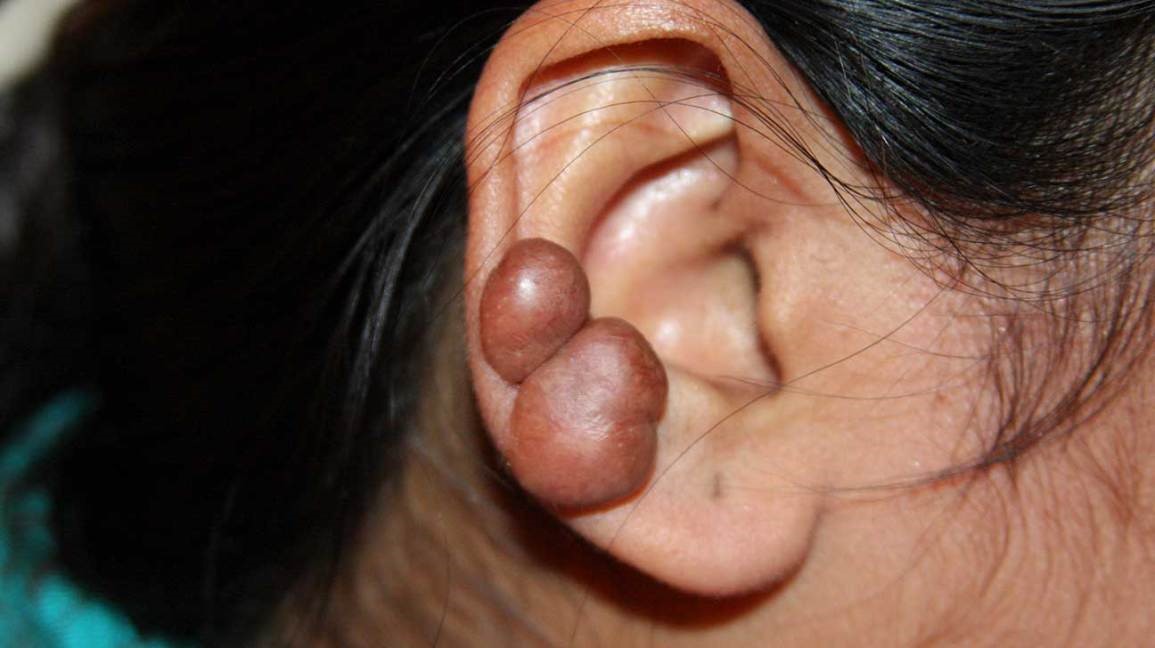
Treatment for keloid scars varies. There is no one simple cure for keloid scars. Recurrence after treatment is common. Treatment may include the following:
- Steroid injections. Steroids are injected directly into the scar tissue to help decrease the itching, redness, and burning sensations that these scars may produce. Sometimes, the injections help to decrease the size of the scar and soften the scar tissue. Atrophy and skin discoloration are the main side effects.
- Cryotherapy. Cryotherapy involves the scar being frozen off.
- Pressure therapy. Pressure therapy involves a type of pressure appliance worn over the area of the scar. These may be worn day and night for up to 4 to 6 months. Their usefulness remains unclear.
- Silicone dioxide. Applied in the form of a gel or pad, this can help soften and decrease the redness of keloids.
- Surgery. If the keloid scar is not responsive to nonsurgical management options, surgery may be performed. One type of surgery directly removes the scar formation with an incision, and stitches are placed to help close the wound. Sometimes, skin grafts are used to help close the wound. This involves replacing or attaching skin to an area that is missing skin. Skin grafts are performed by taking a piece of healthy skin from another area of the body (called the donor site) and attaching it to the needed area. Surgery is not performed often on hypertrophic scars and keloids due to the high rate of recurrence or creation of even larger keloids.
- Laser surgery. Scars may be treated with a variety of different lasers, depending on the underlying cause of the scar. Lasers may be used to smooth a scar, remove the abnormal color of a scar, or flatten a scar. Most laser therapy for scars is done in conjunction with other treatments, including injections of steroids, use of special dressings, and the use of bandages. Multiple treatments may be required, regardless of the initial type of therapy. Pulse dye laser is a good choice to use for keloids.
- Emergent therapies: intralesional 5FU and Bleomycin
- Radiation. This can be used for scars that don’t respond to all other treatments.
Hypertrophic scars
Hypertrophic scars are similar to keloid scars. But their growth is confined within the boundaries of the original skin defect and may be more responsive to treatment. These scars may also look red, and are usually thick and raised. Hypertrophic scars usually start to develop within weeks after the injury to the skin. Hypertrophic scars may improve naturally. But this process may take up to a year or more.
In treating hypertrophic scars, steroids may be the first line of therapy. But there is not 1 simple cure. Steroids may be given as an injection. Or they may be directly applied to the scar, although topical application may not be useful. These scars may also be removed surgically. Often, steroid injections are used along with the surgery. The injections may continue up to 2 years after the surgery to help maximize healing and decrease the chance of the scar returning. Like keloids, hypertrophic scars may respond to topical silicone dioxide application.
hypertrophic scar
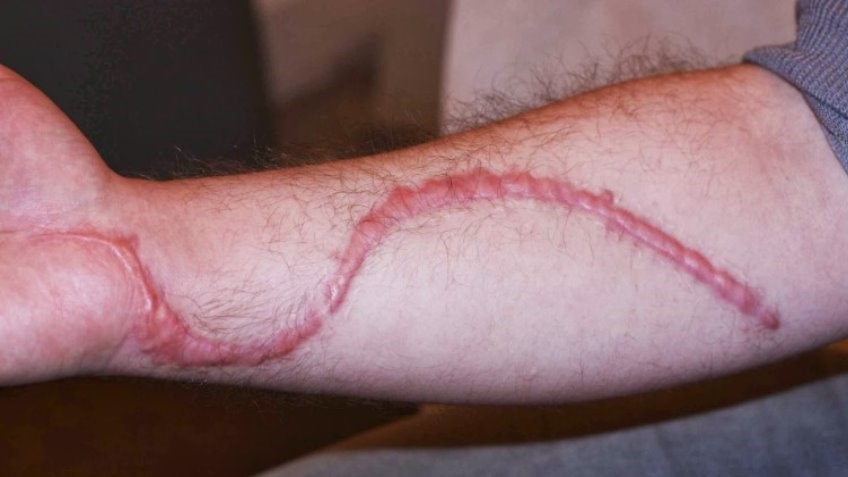
Stretched scars
Hypotrophic or stretched scars are wide thin scars with both edges of normal skin are spread apart. As a normal scar shoud be less than 1mm in width.
hypotrophic or stretched scar
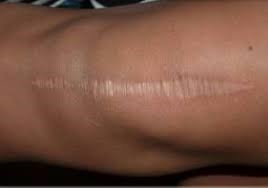
Contractures
Contractures are an abnormal occurrence that happens when a large area of skin is damaged and lost, resulting in a scar. The scar formation pulls the edges of the skin together, causing a tight area of skin. The decrease in the size of the skin can then affect the muscles, joints, and tendons, causing a decrease in movement.
There are many different surgical treatment options for contractures, including the following:
- Skin graft or skin flap. Skin grafts or skin flaps are done after the scar tissue is removed. Skin grafts involve replacing or attaching skin to a part of the body that is missing skin. Skin grafts are done by taking a piece of healthy skin from another area of the body (called the donor site) and attaching it to the needed area. Skin flaps are similar to skin grafts, where a part of the skin is taken from another area. But with the skin flaps, the skin that is taken has its own blood supply. The section of skin used includes the underlying blood vessels, fat, and muscles. Flaps may be used when the area that is missing the skin does not have a good supply of blood. That may be because of the location or because of damage to the vessels.
- Z-plasty. This procedure uses a Z-shaped incision to help decrease the amount of contractures of the surrounding skin. It also may try to relocate the scar so that its edges look more like the normal lines and creases of the skin. Small stitches may be used to help hold the skin in place.
- Tissue expansion. This is a newer technique. It involves a process that increases the amount of existing tissue available for reconstructive purposes. This procedure is often used in addition to the flap surgery.
contracted scar
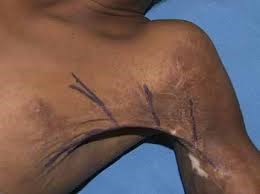
contracted scar after release with Z plasties
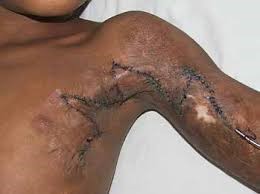
Adhesions
This is another type of scarring that may form between unconnected internal organs. Adhesions may cause complications during certain surgeries.
A thorough analysis to scar and what makes it visible will direct the choice for improving the scar or how to hide it.